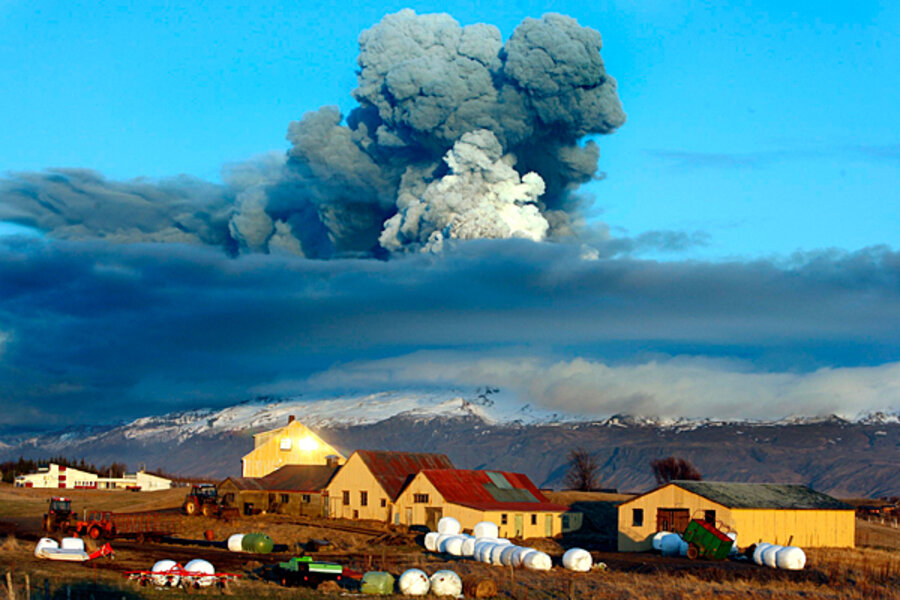Researchers puzzle over how long Iceland volcano will erupt
Loading...
As travelers contend with global airline cancellations and delays triggered by clouds of ash from an erupting volcano in Iceland, researchers are trying to judge just how long the mountain's explosive eruptions might last.
While airlines have coped with eruptions along the Pacific Rim's Ring of Fire, this marks the first time modern Europe – with its high concentration of major airports – has had to cope with the disruptions caused by wind-steered clouds of volcanic ash, researchers say.
On Friday, airlines canceled some 16,000 flights, twice the number of cancellations Thursday. Typically, air traffic hovers around 28,000 flights a day.
Iceland's Eyjafjallajokull volcano, the culprit behind the flight cancellations, has erupted only twice before over the past 1,100 years. The volcano's last active period lasted from 1821 to 1823.
And while the glacier-capped mountain's gently sloping silhouette might suggest a type of volcano more likely to ooze lava than blast ash clouds thousands of feet into the sky, those looks can be deceiving, cautions Benjamin Edwards, a volcanologist at Dickinson College in Carlisle, Pa.
Even volcanoes frequently associated with relatively sedate eruptions can spring surprises, he says.
Typically, volcanoes known for explosive eruptions have magma rich in oxygen and silicates, he explains. And they tend to form conical mountains such as Mt. Fuji in Japan, or Mt. St. Helens, before it erupted in 1980, blasting away the top 1,300 feet of the summit.
Others, with broad, gently sloping sides, such as Hawaii's Mauna Loa, tend to erupt with a thicker, less gas-laden magma that forms fiery fountains in fissures along their flanks, or flows from a main crater.
Yet for such "shield" volcanoes, fresh magma welling up can alter the chemistry of solidified magma from the last eruption, enriching the magma with silicates and oxygen.
One other wildcard is the presence of ice. Meltwater making contact with magma also can trigger an explosive eruption, says Mr. Edwards.
Edward Venzke, with the Global Volcanism Network in Washington, speculates that this is what may have happened in Eyjafjallajokull's case. The network is a collaboration between the US Geological Survey and the Smithsonian Institution's Museum of Natural History.
When the eruption began last month, it did so as a small fissure eruption along a flank of the volcano, he notes. Magma erupted fountain-like, indicating that it contained some gas. But it was more like a typical eruption in Hawaii than Mt. St. Helens.
When that stopped, solidifying magma may have sealed the fissures, allowing pressure to build under the ice-capped summit. As the magma rose, ice melted, providing the water needed to trigger an explosive eruption.
If that's the case, suggests Mr. Venzke, the likelihood that explosive eruptions will continue could shrink with the amount of immediately available meltwater.
But if the explosive nature of the volcano's eruption "is more a function of the composition of the magma, this could go on continuously or episodically for quite a while," he says.
The dust that is such a nuisance to air traffic will provide the information volcanologists need to tell which processes were the most influential in triggering this week's blasts. The clues come not just from the chemical composition of the dust particles, but also in their shapes.
Of some concern is the future of Eyjafjallajokull's neighbor, the Katla volcano, some 16 miles away.
In a recent paper in the journal Developments in Quaternary Science, a team led by University of Gothenburg researcher Erik Stukell notes that the two erupted together in 1612 and again from 1821 to 1823. And their data indicate that Katla is capable of releasing far more material during an eruption than Eyjafjallajokull.
Both showed evidence of a build-up of magma between 1999 and 2004. An increased level of earthquake activity at Katla during those five years, along with a more-inflated shape to the volcano "suggests that the volcano is close to failure," the team cautions.





